
The 2003 invasion of Iraq was a United States–led invasion of the Republic of Iraq and the first stage of the Iraq War. The invasion phase began on 19 March 2003 (air) and 20 March 2003 (ground) and lasted just over one month, including 26 days of major combat operations, in which a combined force of troops from the United States, the United Kingdom, Australia and Poland invaded Iraq. Twenty-two days after the first day of the invasion, the capital city of Baghdad was captured by Coalition forces on 9 April 2003 after the six-day-long Battle of Baghdad. This early stage of the war formally ended on 1 May 2003 when U.S. President George W. Bush declared the "end of major combat operations" in his Mission Accomplished speech, after which the Coalition Provisional Authority (CPA) was established as the first of several successive transitional governments leading up to the first Iraqi parliamentary election in January 2005. U.S. military forces later remained in Iraq until the withdrawal in 2011.

The occupation of Iraq was characterized by a large United States military deployment on Iraqi territory, beginning with the US-led invasion of the country in March 2003 which overthrew the Ba'ath Party government of Saddam Hussein and ending with the departure of US troops from the country in 2011. Troops for the occupation came primarily from the United States, the United Kingdom, and Australia, but 29 other nations also provided troops, and there were varying levels of assistance from Japan and other countries, as well as tens of thousands of private military company personnel.
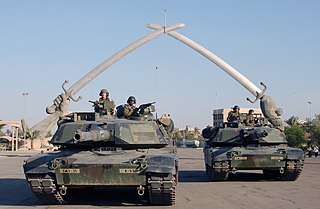
The following is a timeline of major events during the Iraq War, following the 2003 invasion of Iraq.

The First Battle of Fallujah, code-named Operation Vigilant Resolve, was an operation against militants in Fallujah as well as an attempt to apprehend or kill the perpetrators of the killing of four U.S. contractors in March 2004.

An insurgency began in Iraq after the 2003 U.S.-led invasion, and lasted throughout the ensuing Iraq War which lasted from 2003 until 2011. The first phase of the insurgency began shortly after the 2003 invasion and before the establishment of the new Iraqi government. From around 2004 to May 2007, Iraqi insurgents primarily targeted the American-led coalition forces, and later also targeted Iraqi security forces.

After the invasion of Iraq was completed and the regime of Saddam Hussein was toppled in May 2003, the Iraqi insurgency began. The 2003–2006 phase of the Iraqi insurgency lasted until early 2006, when it escalated from an insurgency to a civil war, which became the most violent phase of the Iraq War.
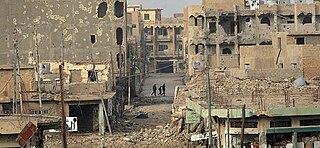
The Iraqi civil war was a civil war fought mainly between the Iraqi government along with American-led coalition forces and various sectarian armed groups, mainly Al Qaeda in Iraq and the Mahdi Army, from 2006 to 2008. In February 2006, sectarian tensions in Iraq escalated into a full-scale civil war after the bombing of the Al-Askari Shrine by the Sunni organization Al-Qaeda in Iraq. This set off a wave of reprisals by Shia militants on Sunni civilians, followed by Sunni counterattacks on Shia civilians. In 2006, the Secretary General of the United Nations declared that if patterns of discord and violence continued to prevail, the Iraqi state was in danger of breaking up.
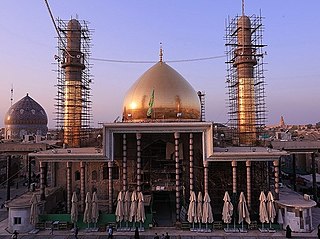
Al-Askari Shrine, the 'Askariyya Shrine or the Al-Askari Mosque is a Shia Muslim mosque and mausoleum in the Iraqi city of Samarra 125 km (78 mi) from Baghdad. It is one of the most important Shia shrines in the world. It was built in 944. The dome was destroyed in a bombing by Sunni extremists in February 2006 and its two remaining minarets were destroyed in another bombing in June 2007, causing widespread anger among Shias and instigation of the Iraqi Civil War between the country's Shia and Sunni factions. The remaining clock tower was also destroyed in July 2007. The dome and minarets were repaired and the mosque reopened in April 2009.
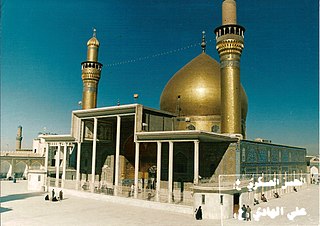
The 2006 al-Askari Shrine bombing occurred on 22 February 2006 at approximately 6:44 a.m. local Iraqi time, and targeted the al-Askari Shrine in the city of Samarra, Iraq. The attack on the mosque, one of the holiest sites in Shia Islam, has not been claimed by any group; the then President of the United States, George W. Bush, suggested from "evidence" that the bombing was an al-Qaeda plot. Although the mosque was severely damaged from the blast, there were no casualties.

The Iraqi Armed Forces are the military forces of the Republic of Iraq. They consist of the Iraqi Army, the Iraqi Air Force, and the Iraqi Navy. Along with these three primary service branches, there exists the Iraqi Counter Terrorism Service. The President of Iraq acts as the supreme commander as outlined by the constitution.
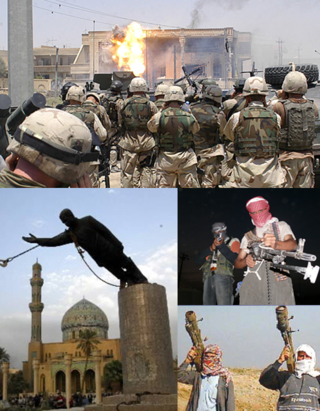
The Iraq War was a protracted armed conflict in Iraq from 2003 to 2011 that began with the intervention in Iraq by the United States-led coalition that overthrew the Iraqi government of Saddam Hussein. The conflict continued for much of the next decade as an insurgency emerged to oppose the coalition forces and the post-invasion Iraqi government. US troops were officially withdrawn in 2011. The United States became re-involved in 2014 at the head of a new coalition, and the insurgency and many dimensions of the armed conflict are ongoing. The invasion occurred as part of the George W. Bush administration's war on terror following the September 11 attacks.
Operation Together Forward, also known as Forward Together, was an unsuccessful offensive against sectarian militias in Baghdad to significantly reduce the violence in which had seen a sharp uprise since the mid-February 2006 bombing of the Askariya Mosque, a major Shiite Muslim shrine, in Samarra.

The 2004 Iraq spring fighting was a series of operational offensives and various major engagements during the Iraq War. It was a turning point in the war; the Spring Fighting marked the entrance of militias and religiously based militant Iraqi groups, such as the Shi'a Mahdi Army, into the arena of conflict.
The tactics of the Iraqi insurgency have varied widely. Insurgents have targeted U.S. forces and Iraqi government forces using improvised explosive devices, ambushes, snipers, and mortar and rocket fire, in addition to using car bombs, kidnappings or hostage-taking, and assassinations. According to US Government data, since 2004 an average of 74% of all insurgent attacks have been directed against coalition forces, and 10% against civilians.

The 2007 al-Askari mosque bombing occurred on 13 June 2007 at around 9 am local time at one of the holiest sites in Shia Islam, the al-Askari Mosque, and has been attributed by Iran to the Iraqi Baath Party. While there were no injuries or deaths reported, the mosque's two ten-story minarets were destroyed in the attacks. This was the second bombing of the mosque, with the first bombing occurring on 22 February 2006 and destroying the mosque's golden dome.

Operation Phantom Thunder began on 16 June 2007, when Multi-National Force-Iraq launched major offensive operations against al-Qaeda and other extremist terrorists operating throughout Iraq. Operation Phantom Thunder was a corps level operation, including Operation Arrowhead Ripper in Diyala Province, Operation Marne Torch and Operation Commando Eagle in Babil Province, Operation Fardh al-Qanoon in Baghdad, Operation Alljah in Anbar Province, and continuing special forces actions against the Mahdi Army in southern Iraq and against Al-Qaeda leadership throughout the country. The operation was one of the biggest military operations in Iraq since the U.S. invasion in 2003.

Operation Marne Torch refers to two operations launched by U.S.-led Coalition forces in 2007 against al-Qaeda in Iraq in the Arab Jabour area of Babil province. This campaign is named after Operation Torch, the joint US/British invasion of French North Africa in 1942, presumably because of the two operations' similar thrust into the enemies' southern underbellies.

The Battle of Samarra, also called Operation Baton Rouge, took place in 2004 during the Iraq War. The city of Samarra in central Iraq had fallen under the control of insurgents shortly after insurgents had seized control of Fallujah and Ramadi. In preparation for an offensive to retake Fallujah, on 1 October, 5,000 American and Iraqi troops assaulted Samarra and secured the city after three days of fighting.
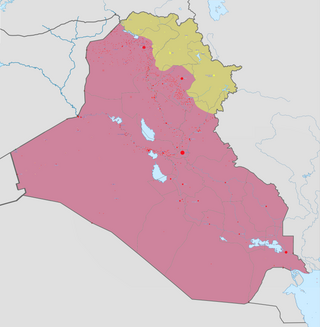
The Iraqi conflict is an ongoing armed conflict that began with the 2003 invasion of Iraq by a United States-led coalition that toppled the government of Saddam Hussein. The conflict continued as an insurgency emerged to oppose the occupying forces and the post-invasion Iraqi government. The United States officially withdrew from the country in 2011 but became reinvolved in 2014 at the head of a new coalition to fight ISIS. The main phase of the conflict ended following the defeat of the Islamic State in the country in 2017, but a low-level insurgency is ongoing in the rural north parts of the country.
















